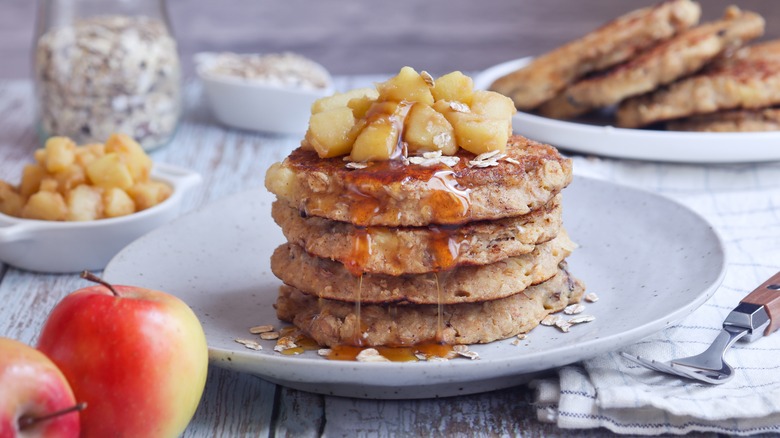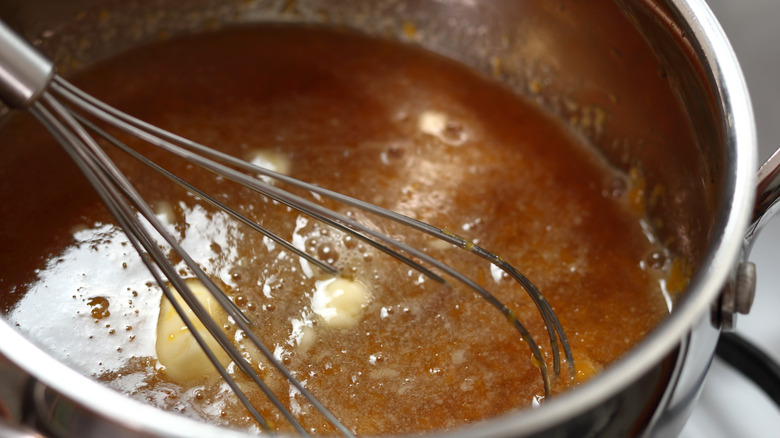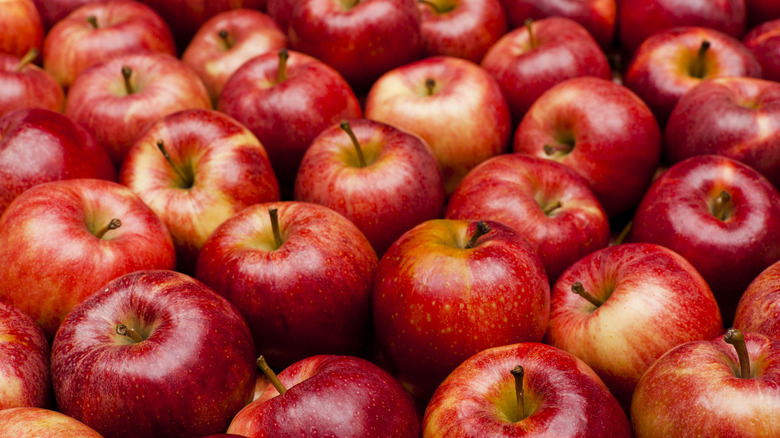Your Pancake Syrup Will Taste Like A Cozy Fall Day With One Simple Swap
Pancakes are inherently comforting. Whether you're making a basic from-scratch buttermilk stack or taking boxed pancakes to the next level, they always hit the spot as a cozy breakfast or breakfast-for-dinner treat. As for toppings, outside of the classic butter-and-syrup route, there are plenty of alternative sweeteners available, from agave syrup to honey to homemade berry compote. For an option that tastes like if you could bottle up the crisp season of crunchy fallen leaves, knit sweaters, and pumpkin spice lattes is a simple apple cider syrup.
Making your own maple syrup is no afternoon DIY project, but this condiment can be yours in less than an hour, requiring only one ingredient (that's right), regular apple cider, plus some patience as it thickens on the stovetop. If you're feeling splurgy, treat yourself to your choice of more artisanal or homemade apple ciders, but any old jug of generic brand stuff from the grocery store will do here — there's no need to shell out for the pricier brands.
Essentially just a reduction of apple cider, this syrup is by adding between ½ and a whole gallon of apple cider to a saucepan, bringing it to a boil, and then simmering it until it becomes concentrated yet still pourable (about 40 minutes to an hour). Additional spices are optional but not required, as the pure apple flavor shines all on its own.
A thick, single-ingredient syrup, no added sugar required
Unlike maple syrup and other choices such as store-bought pancake syrup, the flavor profile of cooked-down apple cider has more of a bright tartness than a one-dimensional sweetness. So, for those who are fans of boozy ciders or more mouth-puckering drinks in general, this syrup could quickly become a new fave.
You'll find some versions on the internet calling for the addition of sugar and butter or thickening agents like cornstarch, but for the most basic recipe, all you need is cider and a large vessel (like a Dutch oven) for cooking it in. After you bring the cider to a boil and lower the heat to a simmer, you can let it bubble away for up to an hour. During this time, the water evaporates, and the consistency turns syrupy.
For a bit of extra fall warmth, you can add one or more spices, just wait until after the boiling stage. Cinnamon is a natural choice, as is ginger, clove, cardamom, or nutmeg. If you go with whole spices rather than powdered, just make sure to strain them out (with cheesecloth or a fine mesh strainer) before enjoying. After removing from the heat, the mixture will thicken even more, after which you can pour the sweet stuff into a resealable container and keep it covered. Any leftovers should last at least a week.
Apple cider syrup dates back to colonial America
This bright, autumnal pancake topping might be a new addition to the sugar alternatives you've tried before, but apple cider syrup is actually a vintage recipe, dating back to well before America was a country. The treat may be a novelty for modern-day palates, but the recipe itself is a long-forgotten one that was once commonplace.
In colonial times, the syrup was heavily relied upon as a way to preserve and put up that year's fresh apple harvest. Also known as apple molasses, the technique of cooking down freshly made apple cider until the water boiled off and left a thick, sappy syrup, would have been common as a sweetener in the 1600s. The practice may have originated with colonial settlers in the Massachusetts area, but in an era when refrigeration was nonexistent and imported sweeteners unreliably available and pricy at best, the popularity of this shelf-stable sweetener spread.
When you're feeling like putting a special twist on the classic hotcake condiments of syrup and a melty pat of butter, infuse your stack with cozy fall vibes and a homespun, Americana flavor with a drizzle of your very own homemade cider syrup. Or do as colonial Americans would have done and use your apple syrup as an all-purpose sweetener — it's equally divine drizzled over a homemade coffee cake or spooned over a bowl of apple-cinammon steel-cut oatmeal.


